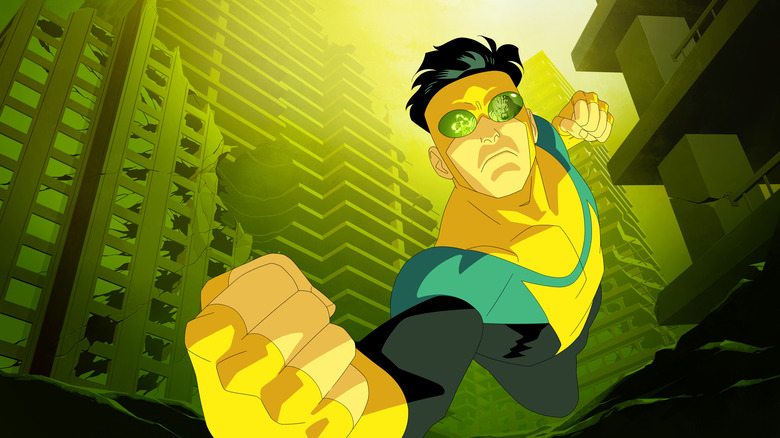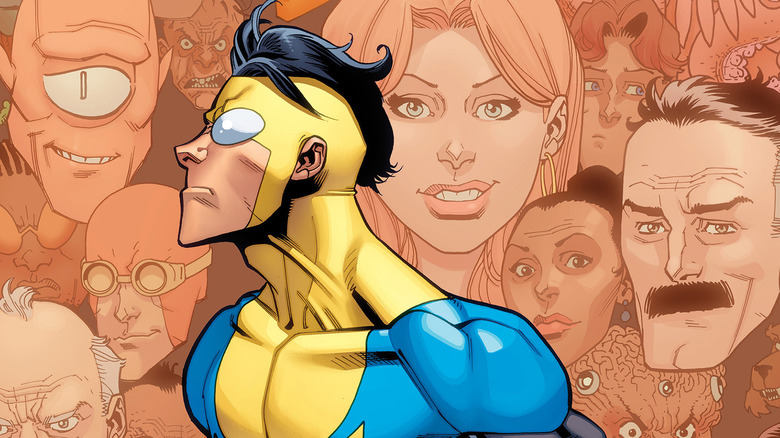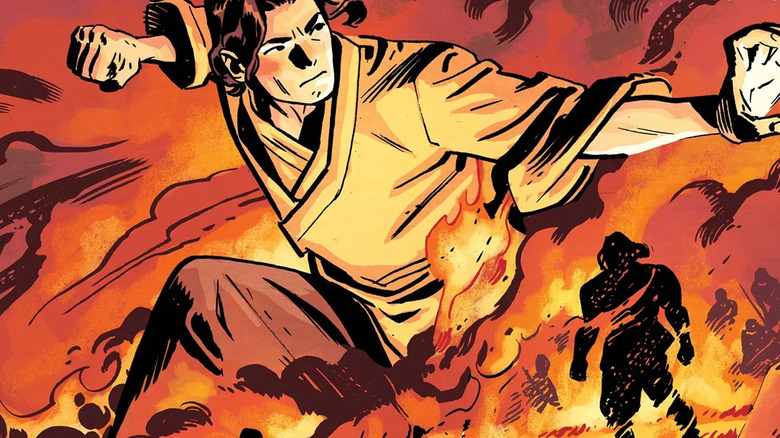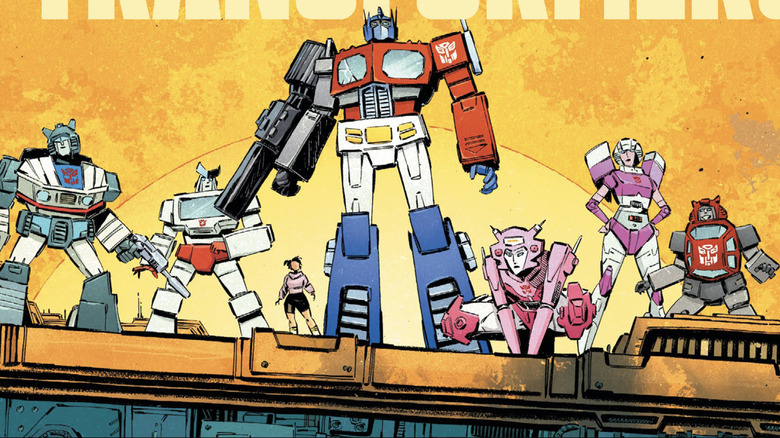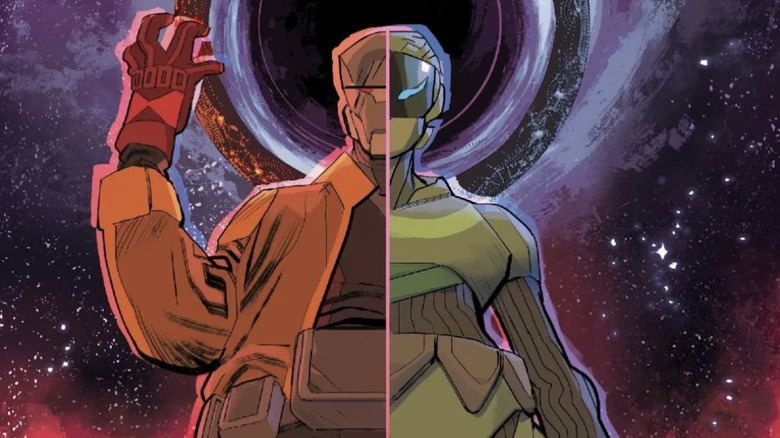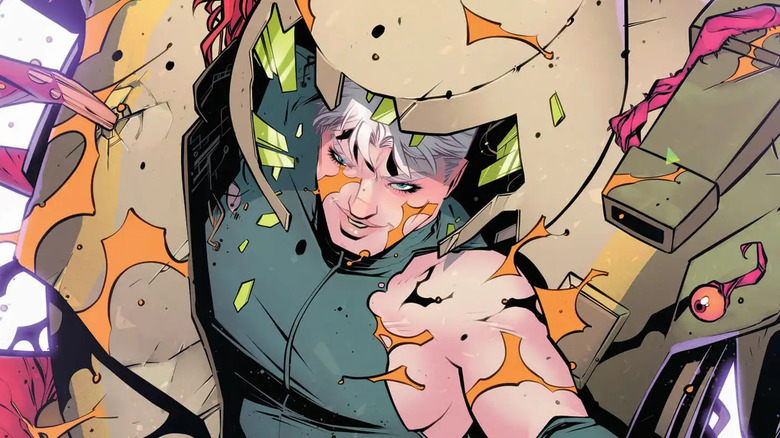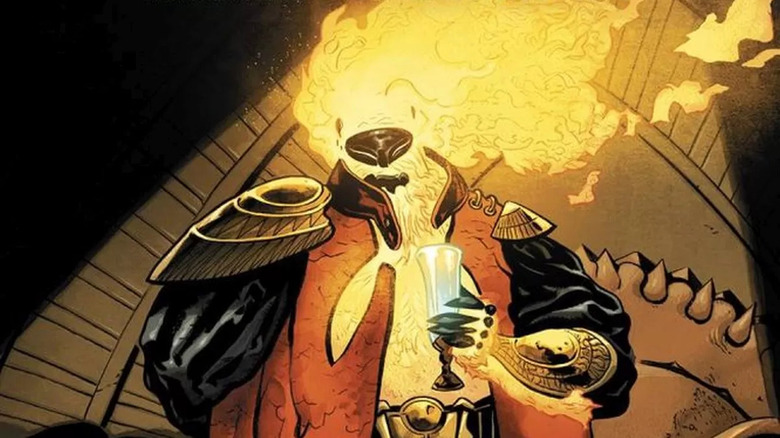The Best Image Comics To Read If You Like Invincible
"Invincible" season 2 just wrapped (read our review here). While the long gap after season 1 slowed down the excitement, the second season kept the show's quality soaring higher than a Viltrumite.
"Invincible" may stream on Prime Video, but its origin story lies at Image Comics. Image was founded in 1992 as counter-programming to the Marvel/DC comics duopoly; the founders included '90s comic superstars like Rob Liefeld, Todd McFarlane, and Jim Lee (the man who rebranded the X-Men for the '90s). The "I" on Invincible's costume? It doesn't just stand for "Invincible," but "Image" too.
At Marvel and DC, the publishers own the characters and cycle out writers/artists at the popular ones. Image, on the other hand, specializes in creator-owned comics where writers and artists retain authority. That's why "Invincible" was personally created by Robert Kirkman, author of the comics. This also means that comics published at Image have more diverse genres than Marvel and DC (crime, horror, science-fiction, westerns, etc.) — though they do dabble in superheroes, "Invincible" being a case in point.
If you like "Invincible," here are some Image comics you should check out. (Note: Kirkman's production company, Skybound Entertainment, is partnered with Image and some of these series fall under that purview).
Invincible
Pretty obvious, huh? If you like "Invincible" the show, you have no excuse to not read "Invincible" the comic (written by Kirkman, drawn first by Cory Walker then by Ryan Ottley). As the saying goes, don't say you love the anime if you haven't read the manga. "Invincible" mimics the comics' art style and character designs so the adjustment will be slow, I promise. Plus, the show is only about a quarter of the way through the story, so if you can't wait for season 3, the comics hold the relief to your suspense.
"Invincible" immodestly billed itself as "The greatest superhero comic in the universe." I don't know about that, but it's pretty great. The comic has all the same virtues as the animated series. Kirkman and Ottley use a paneling layout style called "decompression," where each scene beat gets a single panel instead of trying to cram narration and action into one panel. This means mostly dialogue-free battles can last for whole issues, making "Invincible" a breezy read where you can take in the beautiful, gory art.
Despite the violence and Omni-Man being an example of the "evil Superman" archetype, "Invincible" isn't a superhero deconstruction. It has all of the genre's cliches: a world of heroes in colorful costumes, alien invasions, "Spider-Man" like love triangles, secret identity shenanigans, etc. No, it's just a superhero story unbound by the constraints of Marvel/DC, like an immovable status quo, "the illusion of change," no permanent deaths, PG-violence at most, and no endings. "Invincible" tells a complete tale unencumbered by market-demand resets and is a testament to what superheroes could be if their caretakers were artists, not corporations.
"Invincible" ran for 144 issues and has been collected across 25 serialized paperbacks, 12 hardcovers, and three 40+ issue "compendium" editions.
Fire Power
Robert Kirkman likes to write in his favorite genres. "Invincible" is his own superhero universe, while "The Walking Dead" is the zombie movie that never ends. His recently-concluded series "Fire Power" (drawn by artist Chris Samnee) is a "Dragon Ball" esque martial arts epic.
18 years ago, Chinese-American orphan Owen Johnson made a pilgrimage to the Temple of the Flaming Fist, high in the mountains of China. He trained at the Temple, mastering the forgotten art of "Fire Power," to launch a fireball from one's hands like a dragon breathes flames. The Flaming Fist guards their sanctuary against the Scorched Earth clan, who wish to free a dragon that may or may not be real (this backstory is told in the first volume of "Fire Power" — "Prelude"). In the present, Owen is a happily married family man, but his past comes back to confront him.
Samnee's art sings in "Fire Power." His style, using blocky pencil lines and strong shadows like "Hellboy" creator Mike Mignola, is cartoony without losing all pretense of realism. Like Mignola, this makes his art look just as good in black-and-white as it does in color, but Matt Wilson's coloring of "Fire Power" (from hot reds to cool blues) is essential to the action's intensity.
Like "Invincible," "Fire Power" is decompressed; for action scenes, Samnee often uses diagonal paneling instead of straight boxy borders, letting each beat be illustrated exactly as large as it needs to be. For a skydiving scene in issue #9, he uses slim, vertically aligned panels to convey the characters' falling downwards. Samnee's best drawings, though, are when he leaves the paneling behind entirely for single/double-page spreads, of which "Fire Power" has many.
"Fire Power" ran for 30 issues and has been collected across six volumes.
Transformers
One of the many voice actor stars on "Invincible" is Peter Cullen as Thaedus, leader of the Coalition of Planets. Cullen is the most famous voice of Optimus Prime from "Transformers" and there may be more to this casting.
Skybound acquired the "Transformers" and "G.I. Joe" comic rights in 2023 and has used them to spearhead the new "Energon Universe" (Energon being the Transformers' fuel source). The backbone of this setting is the new "Transformers" comic, written by Daniel Warren Johnson (Johnson also drew the first six issues but has currently ceded art duties to Jorge Corona). "Transformers" takes after the original cartoon in both its character designs and premise; Autobots and Decepticons crash land on Earth and awaken many years later to resume their war.
Johnson is a fan of wrestling and that carries over into how he draws action. The Autobots and Decepticons often do full-body brawling against their opponents, lifting them or slamming them into the ground (as Optimus does to the Decepticon Skywarp in issue #3). The other special ingredient of the action scenes is the sound effects.
Sound is an essential part of "Transformers," from the robots' voices to the metallic clang of gears grinding as they transform. Series' letterer Rus Wooton (previously the letterer of several Image Comic series, including "Invincible" and "Fire Power") understands this. He scribes onomatopoeia into the panels, mimicking audio as best as a soundless medium can. When Optimus rises to victory in issue #6? The lettering declares, "You know the song!", referring to Stan Bush's "The Touch," synonymous with "Transformers" since its use in the 1986 animated movie.
"Transformers" has currently published seven issues. Issue #8 is scheduled to be released on May 8, 2024. Volume 1, "Robots in Disguise," collecting issues #1-6, is scheduled for release on May 21, 2024.
Void Rivals
"Invincible" is half a superhero story, and half a space opera. Kirkman is going full-tilt into the latter with his latest comic, "Void Rivals."
The comic follows two warring peoples, the Agorrians and Zertonians; thanks to a black hole, their planets have collided into a single ring-shaped cosmic entity. When an Agorrian pilot, Darak, crash lands on the same planet as a Zertonian, Solila, they have to learn to work together to survive. Can they also become friends — or at least friendly rivals?
Now let me unbury the lede: "Void Rivals" is set in the "Energon Universe" too! However, it's an original idea, not a pre-existing Hasbro property. Frankly, the galaxy of "Transformers" has always felt underdeveloped; it often feels like Earth, Cybertron, and Cybertronian colonies are the only worlds that matter in the whole cosmos. "Void Rivals" presents a people totally divorced from those worlds, making the universe feel bigger.
Indeed, while there have been "Transformers" cameos to reward attentive fans, the conflict and setting of "Void Rivals" is so far removed you don't need to be reading both books to understand the other. That said, tying these comics together isn't random; they're both about an alien civil war. While "Transformers" depicts a war fought for resources, "Void Rivals" is more about the absurdity of racism.
Artist Lorenzo De Felici crafts his pages in Kirkman's preferred decompressed style and beautifully depicts alien worlds/people. If you like "Star Trek" or "Star Wars," you'll get a kick out of "Void Rivals."
"Void Rivals" has published eight issues so far. Issue #9 (guest starring the Autobot Springer) debuts on May 22, 2024. Volume 1 of "Void Rivals" — "More Than Meets The Eye" — is currently available.
The Forged
Another Image science-fiction series is "The Forged," written by Greg Rucka and drawn by Mike Henderson (whose art has a passing similarity to Ottley's). Set millennia in the future when mankind rules an interstellar empire, the comic follows the Forged, a group of warrior women who wear full-body robot armor (think the Spartans from "Halo," but all female).
"The Forged" wears its pulp roots on its sleeve, lifting from "Aliens," "Dune" (the setting of the first three issues is a desert planet with ravenous worms), and the comics of "Heavy Metal" (a hard R comic magazine published from the 1970s until 2023).
The space opera setting takes Rucka outside his comfort zone; his most famous works are crime comics ("Gotham Central"), spy fiction ("Queen and Country," "Lazarus"), and Earthbound superhero titles ("Wonder Woman," "Batman"). What is totally in Rucka's palette about "The Forged" is the main characters all being badass warrior women. Their camaraderie calls to mind his comic about immortal warriors, "The Old Guard" (adapted into a 2020 film, which Rucka wrote).
While most comics are 20+ pages per issue, "The Forged" uses double-sized issues. You get more story per issue, but the price is higher too ($6.99 per issue).
"The Forged" has published six issues thus far. Issue #7 is scheduled for April 24, 2024. The first two volumes (collecting three issues each) are currently available.
The Sacrificers
"The Sacrificers" is the most off-the-wall pick here, but it's a new favorite of mine. Written by Rick Remender and illustrated by Max Fiumara, "The Sacrificers" takes the imagery of a child's storybook and maps it onto pure horror.
In the fantasy world Harlos, ruled by the sun god Rokos, children dubbed "Sacrificers" are taken every 20 years by the king's Harvesters (their leader wears a mask and cape resembling Krampus, the evil inversion of Santa Claus). What purpose do the Sacrificers serve? That's the question they and the reader are asking during the early issues, as they make their pilgrimage in chains. Meanwhile, Rokos' daughter Soluna (her mother is the moon, hence her name and a crescent-shaped mark on her face) is asking questions about her father too.
In the letters page of issue #1, Remender cites filmmaker David Lynch as his favorite storyteller based on how he lets the audience put the pieces together themselves. "The Sacrificers" isn't as surreal as "Twin Peaks," but it never telegraphs its mysteries either. It's also an example of how comics can be the right medium for a story, not a mere test run for film or TV. The main character is a humanoid, blue-feathered pigeon; in live-action, that would look uncanny and horrifying, but as a mere drawing, the Pigeon looks wholesome; and the emotions Remender wrings from his characters are all the more painful.
"The Sacrificers" joins the hall of stories about children kidnapped for a sinister conspiracy, from "The Hunger Games" (movies ranked here) to "The Promised Neverland." Issue #3 (the most pivotal so far) reminded me of the Pleasure Island sequence in "Pinocchio." If "The Sacrificers" is your jam, I'd also recommend Remender's earlier fantasy series, "Seven to Eternity."
"The Sacrificers" has published seven issues thus far. Issue #8 is due on May 8, 2024. Volume 1 (collecting issues #1-6) is currently available.
